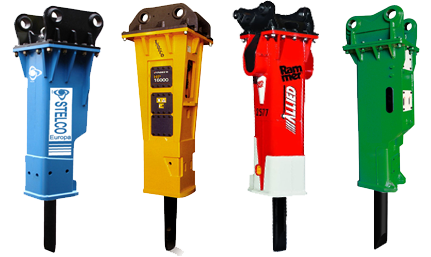Money Saving Tips
Please take just a minute to read these Hammer Tips™
Hammer Tips™ can save you thousands of dollars and lots of headaches. If you have specific questions, please feel free to call. We will do our best to assist you anyway we can.
- Use the correct type of grease. This will reduce tool bit breakage and reduce hammer wear. Do not over grease – this can be messy and detrimental. Never grease a hammer with the tool in the down position.
- Yes, your seals are good and you figure they are water-tight but using your breaker underwater without proper adaptation will cause major problems.
- Correct hammer operating techniques not only increase production but they also reduce tool breakage and tie bolt failure.
- All parts are not the same. This is especially true where hammers are concerned. Breaking rock is hard on the hammer. Hammers beat themselves to destruction. Only fit quality parts to your hammer. Yes, they are more expensive but they greatly increase the time between maintenance and rebuilds. Do you really want to have to tear down your hammer again sooner than you need to? Cheap parts just do not last as long and they can actually cause major costly damage to your hammer. If your local dealer is rebuilding your hammer, insist that he uses only good quality parts.
- Cheap tool bits are harder than quality tool bits. Harder tools are more brittle and more prone to breakage. Harder tools also cause faster hammer wear and piston damage. Use a good grade of tool and avoid tools that are too cheap.
- When laying down hammer, put timber under head end so that the tool is angled slightly downwards. This will prevent rain water getting to the piston and causing corrosion.
- Replace bushings promptly when they are worn. Not doing so can cause major piston and cylinder failure.
- Keeping your oil clean and your hammer free from contamination will save you many thousands. When hammer is not on your excavator, cap off the hoses to prevent ingress of dirt and grit. Grit is very bad for your hammer.
- In the winter months, go easy on your hammer until it warms up. Protect tool bits from frost.
- When choosing a hammer, match it correctly to your carrier and your predominate job types. Bigger is not always better.
- When installing a hammer, use a good plumbing kit with quality components and all the necessary safety reliefs to protect your carrier hydraulics. Always set up your hammer circuit with the correct flows and pressure. This cannot be guessed, it must be set up correctly to prevent hammer problems.
- When choosing a hammer, purchase one that has good parts availability and will likely to have good parts availability for years to come. Hammer companies come and go and you do not want to end up with a very expensive boat anchor.
- Inspect mounting bracket, caseing, welds, bracket bolts daily.
- Do not hammer in the same place for more than 20 secs. If the rock does not break, lift hammer up momentarily and then and put down it down again. This prevents over heating and fine dust build up under the tool bit.
- Always operate the hammer at 90 degrees to the material being broken.Minimise blank or semi blank firing.
Call toll-free 1-877-426-6373 to find out more about useful tips to help you save money when purchasing and operating hydraulic hammers, compactors & attachments. Our staff will happily assist you.

